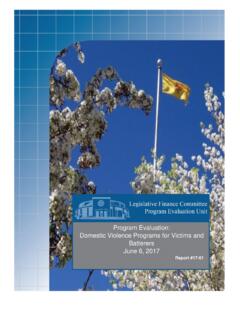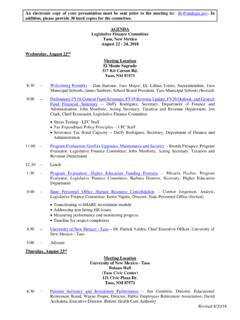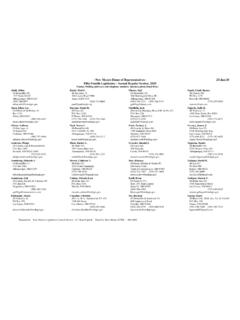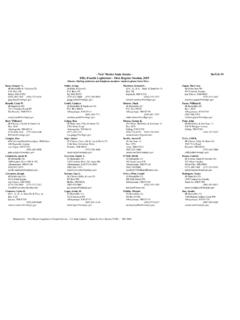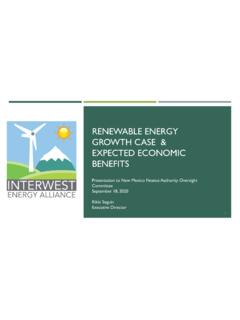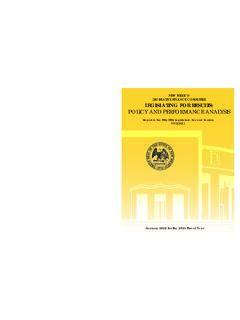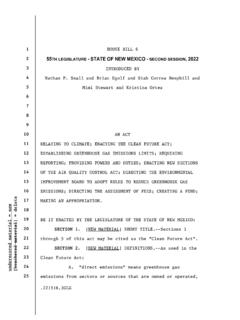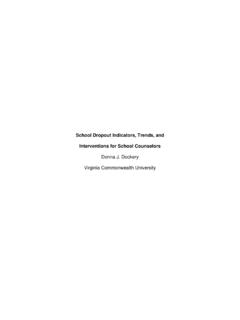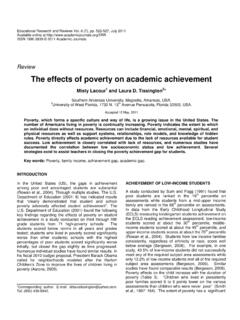Transcription of Learning Loss Due to COVID-19 Pandemic - nmlegis.gov
1 Learning Loss Due to COVID-19 . Pandemic Summary Though necessary to combat the spread of COVID-19 , school closures and issues with remote Learning will likely lead to New Mexico's children losing the equivalent of three months to an entire year of Learning . This loss is expected to impact younger, at-risk children more. On March 13, 2020, the governor ordered schools to close for three weeks, starting on March 16, in response to the COVID-19 Pandemic . On March 27, the governor extended school closures through the remainder of the school year. Along with this announcement, the Public Education Department (PED) waived requirements to make up instruction for the three weeks of closures and instead required schools to develop continuous (distance) Learning plans for the remainder of the year.
2 In response to New Mexico school Children will need to catch up closures, this policy spotlight seeks to document the after the COVID-19 Pandemic transition to distance Learning , determine the range of Learning loss due to school closures, and recommend caused three months to a year strategies to make up for these losses. of Learning loss. While the move to distance Learning was unavoidable, the early closing of schools inherently exacerbated summer Learning loss. Further, certain factors like differing access to the internet, computers, and parental engagement mean that at-risk children will likely start the upcoming school year farther behind than their more affluent peers.
3 To avoid further widening existing achievement gaps, safely reopening schools and making up lost- Learning time must be a top priority for New Mexico. Guidelines from the federal Centers for Disease Control and Prevention should make it possible to reopen schools, and some states have already opened their schools for summer school and fall in-person instruction. Although summer and extended Learning programs could potentially help address Learning loss, PED has canceled K-5 Plus extended school year programs for FY21, which would have added an additional 25 instructional days leading into the new school year for participating districts.
4 PED recently convened a reentry task force to develop guidelines for reopening in the fall, which must address unique challenges to reopen schools in New Mexico, including accommodating an older teacher workforce and accounting for the second-highest rate of infected children in the nation. However, strong guidance with an emphasis on addressing Learning loss will help New Mexico mitigate the effects of lost Learning time and ensure a COVID-19 slide does not exacerbate the existing achievement gap highlighted by the Martinez and Yazzie v. New Mexico consolidated education sufficiency lawsuits. LFC staff would like to acknowledge and thank Legislative Education Study Committee staff and Public Education Department staff for their thoughtful contributions to this report, particularly with continuing Learning plans.
5 LFC staff would also like to thank the 4,170 teachers who responded to the LFC teacher survey, representing 73 districts and 15 charter schools, teachers and staff who participated in group forums, and parents who participated in interviews and group forums. Spotlight Program Evaluation Unit Legislative Finance Committee June 10, 2020. New Mexico's Children Will Start the 2020- 2021 School Year Three Months to a Year Behind In response to the COVID-19 Pandemic , public schools closed for three weeks Continuous Learning Plan (CLP): A school district's plan in March. Subsequently, PED provided guidance for continuous distance on how to meet the needs of Learning , encouraging districts to focus on previously taught materials supporting Learning outside of (enrichment) and to plan to cut instructional time to a fraction of the normal normal educational practices.
6 School day. Districts submitted continuous Learning plans (CLP) to PED. In normal years, most students lose between one to two months of Learning over the summer break (a phenomenon referred to as the summer slide.) Due to the unavoidable early school closures, however, students will lose substantially more Learning time than normal, partly because of low student engagement. School closures will exacerbate Learning loss over the summer, leaving students three months to a year behind. Not considering the reduced time on task for younger children, Learning loss will likely be greater for younger children.
7 Researchers from the Northwest Evaluation Association (NWEA) examined data on the summer slide phenomenon, in which students, particularly those in low-income families, lose months of reading and math knowledge. Due to school closures and less time spent on instruction, this year's losses are likely greater than normal summer Learning loss. Using testing data to forecast how much further students would fall behind due to early school closures, NWEA projected students will return next year with only 70 percent of their typical gains in reading and less than 50 percent of the expected gains in math.
8 In other words, instead of a usual one- to two-month loss in knowledge content, students could return to school in the fall three months to a year behind due to school closures. The NWEA researchers note that, to help mitigate the potential slide, educators will need assessment data to guide curriculum and instruction, especially to target resources and support for students most impacted by the COVID-19 . school closures. PED should work collaboratively across stakeholder groups to determine how to best collect and utilize formative assessment data to inform instruction. Page 2 Spotlight: Learning Loss Due to COVID-19 .
9 Pandemic June 10, 2020. Figure 1. Projected Learning Loss in Math and Reading Due to COVID-19 Slide Source: Kuhfeld, M. & Tarasawa, B. (2020). The COVID-19 slide: What summer Learning loss can tell us about the potential impact of school closures on student academic achievement. NWEA. McKinsey & Company found that if schools delay reopening until January 2021, students will suffer an additional three to 14 months of Learning losses. McKinsey's model also showed that these losses would hit low-income, black, and Hispanic students the hardest, and would exacerbate existing achievement gaps by 15 to 20 percent.
10 Longer-term, the McKinsey study monetized the impact of lost Learning , modeling that it would lead to increased high school drop-out rates and cost the average student between Spotlight: Learning Loss Due to COVID-19 Page 3. Pandemic June 10, 2020. $61,000 to $82,000 in lifetime earnings, or the equivalent of a year of full-time work, solely as a result of COVID-19 related Learning losses. Figure 2. Average Months of Learning Lost if Schools Resume In- Class Schooling in January, 2021. The result is Learning loss from student disengagement and/or lack of access Note: Estimates based on income quintiles that top 2 income quintiles receive high-quality instruction.
